The week at a glance
- Upland Sandpiper, Solitary Sandpiper, Wilson's Snipe and Northern Waterthrush on Scilly
- Rose-breasted Grosbeak in Orkney
- Sandhill Crane still in Suffolk
- Short-toed Eagle on Jersey
- Solitary Sandpiper in Lancashire
- Semipalmated Plover and probable Western Sandpiper in Co Kerry
- American Black Tern still in Lincolnshire
- Buff-bellied Pipits in East Sussex and Shetland
- Black Scoter and possible Little Shearwater in Northumberland
Many of last week's quality birds lingered into this week, but there was a continued slow trickle of new birds to whet the appetite. Not all were accessible or were merely 'reported', but the interest levels remained high.
On the sea, presumably one of the regular Black Scoters popped up again, off Goswick (Northumberland) on 11th–12th. Also in the county, a possible North Atlantic Little Shearwater headed north past Tynemouth on 8th. The raptor highlight of the week was a Short-toed Eagle at La Coupe (Jersey) on 10th–11th, which may be the bird first seen on 20th September.
The Sandhill Crane stayed put long enough for many to catch up with it: it showed well at Boyton Marshes (Suffolk) to 7th, when it headed off high to the south. Despite plenty of bins trained on the sky south of here and into Essex, it wasn't seen again. The juvenile Semipalmated Plover remained at Ventry (Kerry) to at least 10th and Lancashire's first Solitary Sandpiper also remained at Nateby to 6th.

Solitary Sandpiper, Nateby, Lancashire (Photo: Andy Hood)
On Scilly, both the Northern Waterthrush and Solitary Sandpiper remained, the latter to 6th only, but it was two new arrivals that stole the show. The year's first Upland Sandpiper was found at Maypole, St Mary's on 8th and showed well for the rest of the day. It wasn't present the next day but was soon relocated at Borough Farm, where it remained to 12th. Scilly and Cornwall hold the lion's share of records of this vagrant, but apart from a brief bird in 2010 this is the first Scilly record since 1999. There was then a second bird, on The Mullet (Mayo) on 12th, just two days later than the only other county record (at the same site in 1988).
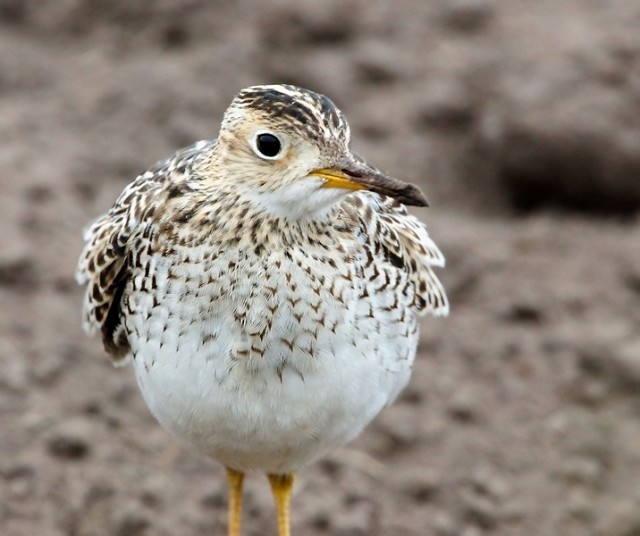
Upland Sandpiper, St. Mary's, Isles of Scilly (Photo: Dave Perrett)
Upland Sandpiper, St. Mary's, Isles of Scilly (Video: benjimi1)
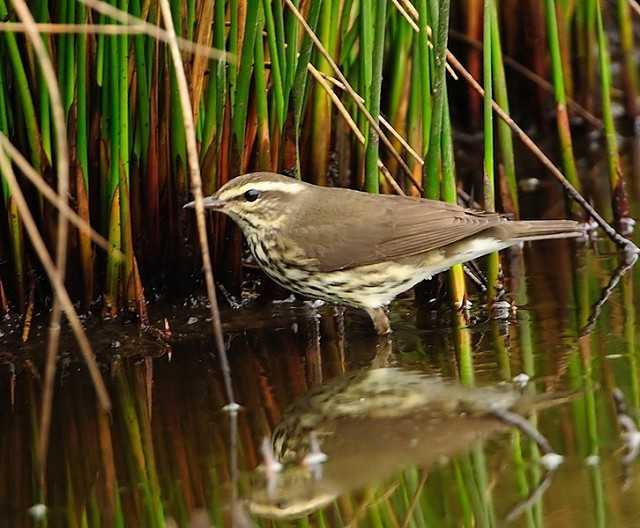
Northern Waterthrush, St. Mary's, Isles of Scilly (Photo: Dave Perrett)
Back on Scilly, the probable Wilson's Snipe was finally nailed once photographs of its spread tail revealed the diagnostic 16 tail feathers (Common Snipe generally have just 14). After the first in 1998, there were four records in 2007 and one in 2008, so this species has unjustly lost its mega status, though a mainland record would be much appreciated!
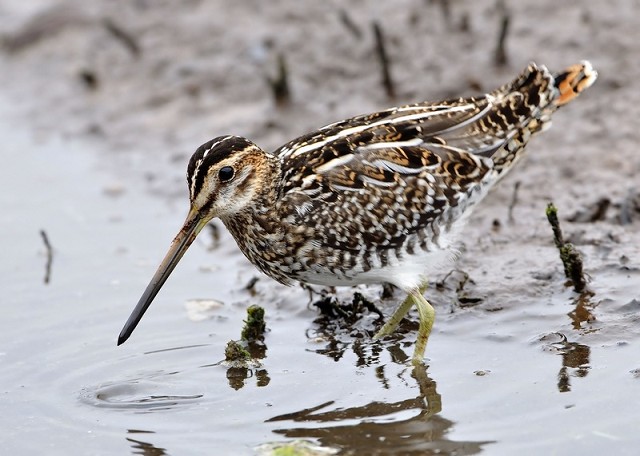
Wilson's Snipe, St. Mary's, Isles of Scilly (Photo: Dave Perrett)
Having not been reported since 4th, the juvenile American Black Tern was again at Covenham Reservoir (Lincs) on 7th.
Shetland saw another Buff-bellied Pipit this week, at Quendale on 8th–11th, but rousing more interest was one photographed at Newhaven (East Sussex) on 9th. Photos were posted online and opinion swung one way and then the other, but finally settled firmly in the Buff-belled camp. There were no further reports of this bird until 12th, when it was refound, allowing some to catch up with this county first. There are few records from the British mainland, all of them in the last 10 years: in Lincolnshire in winter 2005/06 and in Cornwall and Oxfordshire in October 2007.
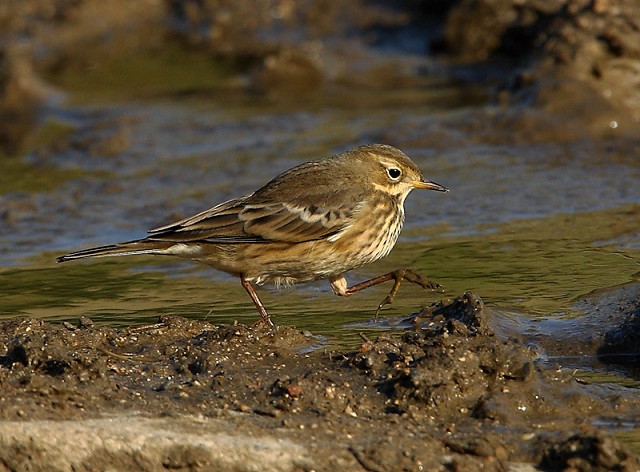
Buff-bellied Pipit, Quendale, Mainland, Shetland (Photo: James Wood)
Another bird missed by the masses was a Rose-breasted Grosbeak on Eday (Orkney) on 10th. Seen by just the finders, the description seems to favour this being a first-winter male, but unfortunately it couldn't be refound. This is just the third record for Scotland, following two Outer Hebrides birds, on North Uist in October 1983 and on Barra in October 2005.
Two other reports perhaps worthy of mention involve birds reported by members of public, which may or may not be the real deal. These were a Northern Flicker belatedly reported from Blue House Farm (Essex) on 23rd September and a Blue Rock Thrush (or Rock Thrush or Superb Starling) in East Ruston (Norfolk) on 9th–10th. Last but by no means least by recent standards, an adult gull at the Grafham Water roost (Cambs) on 7th showed some features suggesting Black-tailed Gull, though despite much searching it wasn't relocated.
As Barnacle Geese returned to Loch Gruinart (Argyll), so also returned a Richardson's Canada Goose from 6th, joined by a second bird on 9th–10th, at what is becoming a very reliable site for the species. The white-morph Snow Goose was again at Craobh Haven (Argyll) to 9th, another was on Barra (Outer Hebrides) again on 7th and a possible (or Ross's Goose) was at Aberlady Bay (Lothian) on 11th. The juvenile Red-breasted Goose also remained at Scaling Dam Reservoir (Cleveland) to 11th, though is now thought to be an escape. The first Ruddy Shelducks for a while were three over Nettleton (Lincs) on 9th. A single Black Brant was reported, at Leigh-on-Sea (Essex) on 11th.
The drake American Wigeon at Wellington Gravel Pits (Herefordshire) remained to 9th and one at Loch Bee, South Uist (Outer Hebrides) stayed all week, while in Ireland the female Blue-winged Teal was again reported from Bull Island (Dublin) on 8th. There was also just one Green-winged Teal, at Glounthaune (Cork) on 9th. A new drake Ring-necked Duck was at Kirkby-on-Bain (Lincs) on 6th–9th and another remained at Chew Valley Lake (Somerset). The lake also saw the regular drake Ferruginous Duck all week and others also remained at Pitsford Reservoir (Northants) to 9th and at Dinton Pastures and Lavell's Lake (Berks) to 9th. The only new bird was a first-winter drake at Far Ings (Lincs) on 9th–12th, the first in the county for a couple of years.

Ring-necked Duck, Kirkby on Bain GPs, Lincolnshire (Photo: Trevor Gunby)
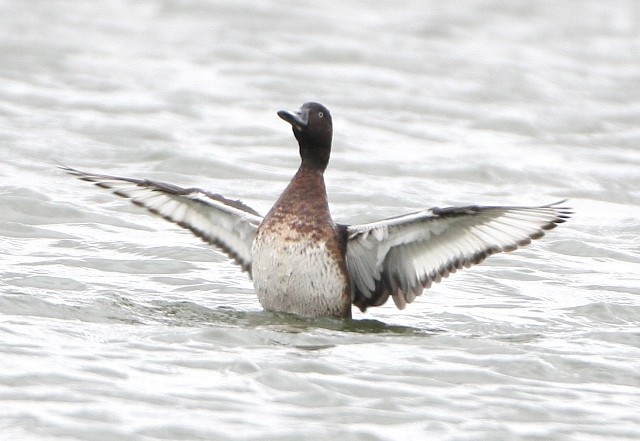
Ferruginous Duck, Far Ings NR, Lincolnshire (Photo: Paul Thomas)
A Lesser Scaup was new in at Marden Quarry (Northumberland) on 9th–12th, also seen on Tynemouth Boating Lake on 10th. This is just the third record for the county, following birds in May 1999 and May 2007. Also new in was an individual on Fair Isle (Shetland), the first record for the island. A new drake Surf Scoter was in Largo Bay (Fife) on 8th and another remained in Burghead Bay (Moray & Nairn) to 8th.
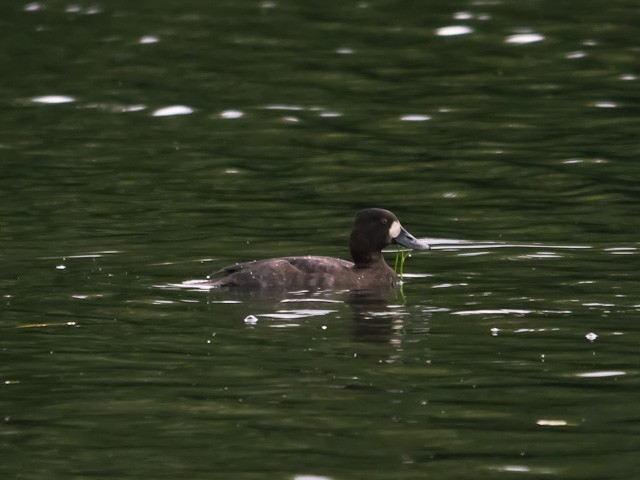
Lesser Scaup, Tynemouth, Northumberland (Photo: Arto Maatta)
Following the multiple records of a Fea's Petrel in East Anglia in recent weeks, there was a further report of one (or the same) off Thorpeness (Suffolk) on 10th, where there was also a Cory's Shearwater. There was then one off North Ronaldsay (Orkney) on 12th. Several other Cory's were reported from Suffolk and Essex, and there was one past Collieston (Aberdeenshire) on 9th. Great Shearwaters were seen from Pendeen and St Ives (Cornwall) during the week, including three past the latter on 6th. There were also four from the Scilly pelagic on 11th and one past Seafield (Clare) on 6th. Good numbers of Leach's Storm-petrels continued to be reported from western coasts at the start of the week, including 30 past New Brighton (Cheshire) and 23 past Point of Ayr (Clwyd) on 7th and 13 past Griminish Point, North Uist (Outer Hebrides) on 9th. There were also good numbers of Balearic Shearwaters, peaking at 160 off Pendeen (Cornwall) on 6th and 40 past Porthgwarra (Cornwall) on 12th. Most were from southern sites, though there were reports from Whitburn Coastal Park (Durham) on 7th, Copeland Island (Down) on 9th and New Brighton (Cheshire) on 6th.

Great Shearwater, at sea, Isles of Scilly (Photo: Ashley Fisher)
There was a slight westerly bias to records of Sabine's Gull this week, with all birds being coastal. Notable counts included nine past Strumble Head (Pembrokeshire) on 7th, eight past Pendeen (Cornwall) on 6th, eight past Ramore Head (Antrim) on 7th and seven past Bridges of Ross (Clare) on 6th. Better numbers of Grey Phalaropes were reported this week, including 15 past Melmore Head (Donegal) on 7th and up to four at Ardivachar Point (Outer Hebrides).

Sabine's Gull, Workington, Cumbria (Photo: Craig Shaw)

Grey Phalarope, Coldharbour Lagoon, Kent (Photo: Adrian Dowling)
Great White Egrets were reported from 11 sites, including two together at both Shapwick Heath and Ham Wall (Somerset) and Parkgate Marsh (Wirral). New birds were at the Cotswold Water Park (Wilts), King's Bromley Gravel Pits (Staffs), Yoxall (Staffs), Leighton Moss (Lancs), Amble Marshes (Cornwall) and Gayhurst Quarry (Bucks). The long-staying Cattle Egret was on Thorney Island (West Sussex) on 9th and another was seen over Margate (Kent) on 7th. The adult Night Heron moved to Ham Wall (Somerset) on 6th and the only White Storks reported were North Yorkshire escapees.

Great White Egret, Shapwick Heath NNR, Somerset & Bristol (Photo: Malcolm Menzie)
The arrival of Glossy Ibis continued apace, and new singletons were at Dungeness (Kent) on 6th–9th, Tacumshin and Lady's Island Lake (Wexford) on 8th–10th, Newport Wetlands (Gwent) on 9th and Dromsullivan (Cork) (two) on 9th. One was also at Dingle Marshes and Minsmere (Suffolk) on 7th–10th, and two more went over Minsmere on 10th. Remaining birds from last week included up to 17 at Courtmacsherry and Kilmaloda (Cork) to 10th, three at Stanpit Marsh (Dorset) to 12th and singletons at Brading Marsh (Isle of Wight) to 7th and Stithians Reservoir (Cornwall) to 11th.

Glossy Ibis, Minsmere RSPB, Suffolk (Photo: Ian Clarke)
Two of Cornwall's Black Kites continued to be seen around Catchall all week and another was also still at Polgigga to 11th. Another also remained on St Mary's (Scilly) to 7th, and in Dorset possibles were over Bournemouth on 9th and Ferndown on 11th. In Shetland, Pallid Harriers roamed various sites in the south of the mainland and a juvenile was at Bardister on 9th. Further south, reports were rather more limited than in recent weeks: one remained at Black Down (Somerset) to 8th, one passed St John's Point (Down) on 12th and possibles were at Silverhill Wood (Notts) on 8th (perhaps present for a week) and Elmley Marshes (Kent) on 7th. The County Down bird is just the second record for Northern Ireland, following one in County Antrim in April. There were single raptor representatives of winter and summer, a Rough-legged Buzzard at Ward Hill (Orkney) on 8th and a female Red-footed Falcon at Christchurch (Dorset) on 9th.

Black Kite, St. Buryan, Cornwall (Photo: Ross Lawford)
Two new Spotted Crakes were reported this week, at Beddington Sewage Farm (London) on 7th and at Higher Moors, St Mary's (Scilly) on 9th; the latter may have been the same crake sp. that was seen on Porth Hellick Pool on 10th.
American Golden Plovers remained at numerous sites across the country, including seven in Scotland and five in Ireland (with two at Carrahane Strand (Kerry) on 8th). Apart from two on Scilly, there was just one other in England, at Newbiggin-by-the-Sea (Northumberland) on 11th.

American Golden Plover, Newbiggin-by-the-Sea, Northumberland (Photo: Stef McElwee)
The good run of waders on Scilly was bolstered by the remaining Least Sandpiper on Tresco to at least 11th and Lesser Yellowlegs on St Mary's and Tresco all week. Other Lesser Yellowlegs were at St Clement (Cornwall) to 11th and again in Findhorn Bay (Moray & Nairn) on 6th, and a new bird was at Bornish, South Uist (Outer Hebrides) on 6th–9th. Both of the long-staying Spotted Sandpipers, on the Plym Estuary (Devon) and at Chew Valley Lake (Somerset), remained all week, one returned to Scolpaig, North Uist (Outer Hebrides) after a week-long absence and a new juvenile was at Knockadoon Head (Cork) on 6th.

Lesser Yellowlegs, St. Mary's, Isles of Scilly (Photo: Dave Perrett)

Spotted Sandpiper, Knockadoon Head, Cork (Photo: Ronan McLaughlin)
Long-billed Dowitchers remained at Baron's Haugh (Clyde) to 7th and on the Lossie Estuary (Moray & Nairn) to 6th and there were three new birds in Scotland: at Caerlaverock (Dumfries & Galloway) on 7th–12th, at Lochlea (Ayrshire) on 7th–11th (the Baron's Haugh bird perhaps?) and at West Gerinish, South Uist (Outer Hebrides) on 10th–11th. In Wales one remained at Kidwelly (Carmarthenshire) to 11th, and in England one was at Davidstow Airfield (Cornwall) on 7th–8th and two together at Blagdon Lake (Somerset) on 10th relocated to nearby Chew Valley Lake on 11th–12th. Records of two birds are rather rare, but this occurrence mirrors one from 35 years ago, when two birds at Chew Valley on 30th September later moved to Blagdon, staying to January 1978.

Long-billed Dowitcher, Davidstow Airfield, Cornwall (Photo: Jon Mercer)
Long-billed Dowitcher, Caerlaverock WWT, Dumfries & Galloway (Video: FoghornsBirdingVideo)
There were far fewer Semipalmated Sandpipers reported this week, but by now birds are perhaps more widely scattered around the country and there for the finding. English birds remained at Coalhouse Fort (Essex) to 9th and Davidstow Airfield (Cornwall) to 6th, and in Scotland a bird was at Ardivachar Point, South Uist (Outer Hebrides) to 7th. Irish birds were at four sites: there were new birds at Clonakilty (Cork) on 7th–8th and Muckross (Donegal) on 8th, the bird at Corragaun Marsh (Mayo) was last seen on 6th and three remained at Tacumshin (Wexford) to 11th (along with the Least Sandpiper, eight Buff-breasted Sandpipers, White-rumped Sandpiper, Pectoral Sandpiper and 10 Curlew Sandpipers).

Semipalmated Sandpiper, Ardivachar Point, S. Uist, Outer Hebrides (Photo: Steve Duffield)
The Outer Hebrides saw three White-rumped Sandpipers during the week, two on South Uist and one on Lewis. Others were at Castletown (Highland) on 6th, Fenham Flats (Northumberland) on 7th and Black Rock Strand (Wexford) on 7th. South Uist also saw a Baird's Sandpiper, at Baile Gharbhaidh to 11th, and just two others were reported, at Bannow Bay (Wexford) on 11th and Loch Stiapavat, Lewis (Outer Hebrides) on 12th.
Numbers of Pectoral Sandpipers also dropped off, with birds reported from over 25 sites, including seven in western Scotland, peaking at eight at West Gerinish, South Uist (Outer Hebrides) on 7th. In the east, singletons remained at Saltholme (Cleveland), Frampton Marsh (Lincs) and Dungeness (Kent) and new birds were at Horse Shoe Point (Lincs) on 6th, Gibraltar Point (Lincs) on 7th–10th and Nosterfield Quarry (North Yorks) on 8th–11th. In the west, two were at Stithians Reservoir (Cornwall) and two remained at Chew Valley Lake (Somerset). It was Buff-breasted Sandpipers that noticeably moved on, though, down from 21 sites last week to just nine this week. Apart from eight at Tacumshin, two were on St Mary's (Scilly) and singletons were at Newport Wetlands (Gwent), Lowtherstone (Dublin), Rye Harbour (East Sussex) and on the Outer Hebrides at Barvas (Lewis), Loch Sandary (North Uist), and Bornish (South Uist).

Pectoral Sandpiper, Gibraltar Point NNR, Lincolnshire (Photo: Paul Neale)
Coastal Pomarine and Long-tailed Skuas were widespread, but rarely numerous. Peak counts of Long-taileds included eight past Kilcummin Head (Mayo) on 7th (with 79 Poms, six Sabine's Gulls and 44 Grey Phalaropes&) and four past Spurn (East Yorks) on 8th (with 46 Poms). The usual Glaucous Gull was at Dungeness (Kent) and the week saw the arrival of two new birds, at Cowes (Isle of Wight) on 10th and a juvenile at Hetton Leys (Durham) on 11th.

Pomarine Skua, The Wash, Lincolnshire (Photo: Russell Hayes)

Pomarine Skua, Bridlington RSPB Skua Cruise, East Yorkshire (Photo: Anthony Capuano)

Long-tailed Skua, The Wash, Lincolnshire (Photo: Russell Hayes)
In the roosts, a possible Baltic Gull came to roost at Chasewater (Staffs) on 9th and the probable Azorean Yellow-legged Gull was again at Grafham Water (Cambs) on 6th. A new second-winter Ring-billed Gull was in Stornoway Harbour, Lewis (Outer Hebrides) on 9th–10th, whilst the regular bird remained at Cardigan (Ceredigion) to 11th. There were just two adults, at Stranraer (Dumfries & Galloway) on 11th–12th and one returning to Dunbeg (Argyll) on 12th. In Orkney, an adult Bonaparte's Gull was at Lamb Holm and Graemeshall on 6th–8th, and the adult also remained at Weir Wood Reservoir (East Sussex) to 7th. Other new birds were at Larne Lough (Antrim) on 10th–11th and a possible seen briefly past Watton (East Yorks) on 7th.
The only Pallid Swift reported was a possible south over Minsmere (Suffolk) on 6th. All of the week's Wrynecks were at coastal sites in the south and west, with the furthest north on Bardsey Island (Gwynedd) on 7th–11th (two on 9th). Others were widespread between Dorset and Cork, with birds at numerous sites in west Cornwall and on Scilly, including at least three birds in private gardens.

Wryneck, Kynance Cove, Cornwall (Photo: Ross Lawford)
The Short-toed Lark remained on St Mary's airfield (Scilly) all week, as did one on North Ronaldsay (Orkney), and others were on Cape Clear (Cork) on 11th–12th and on Fair Isle on 6th. Shetland saw the only Citrine Wagtail of the week, a first-winter at Fleck on 6th–11th. Last week's run of Richard's Pipits ended rather abruptly: just four were reported this week, all flight records, over Holy Island (Northumberland) on 7th, Voe (Shetland) on 8th, Sizewell (Suffolk) on 9th and Cley Marshes (Norfolk) on 10th. The only Tawny Pipit was at Burnham-on-Sea (Somerset) on 12th. The week's three Olive-backed Pipits were all on Shetland, at Skibberhoull (Whalsay), Quendale (Mainland) and Baltasound (Unst). At the other end of the country, Red-throated Pipits were on St Mary's (Scilly) on 10th–12th and Ballymaloe (Cork) on 10th and another was at Spurn (East Yorks) on 9th.

Short-toed Lark, Cape Clear, Cork (Photo: Ronan McLaughlin)

Red-throated Pipit, St. Mary's, Isles of Scilly (Photo: Dave Perrett)
Some of the most spectacular "vis mig" of the autumn so far was seen this week, including the mass arrival of winter thrushes. The peak count was at Spurn (East Yorks) on 12th, totalling 8300 Redwings, 1700 Fieldfares and nine Ring Ouzels. Also of note were the large numbers of Crossbills on the move, and incredible counts were reported of 380 over Angmering (West Sussex) on 9th and 154 over Durlston Country Park (Dorset) on 10th, with 107 the next day.

Ring Ouzel, Church Norton, West Sussex (Photo: Brian Harrison)
There were just four records of Red-backed Shrikes this week: birds remained at Porthgwarra (Cornwall) and Tresco (Scilly) to 8th and new birds were at Crookhaven (Cork) on 7th–12th and on Tiree (Argyll) on 9th–11th. The week's only Great Grey Shrike was in Langdale Forest (North Yorks) on 11th. Two juvenile Woodchat Shrikes comprised one new in at Galley Head (Cork) and a photogenic bird at Lowestoft (Suffolk, both on 8th–12th. In Shetland, two nearby Daurian Shrikes in differing plumages made for an illuminating contrast.
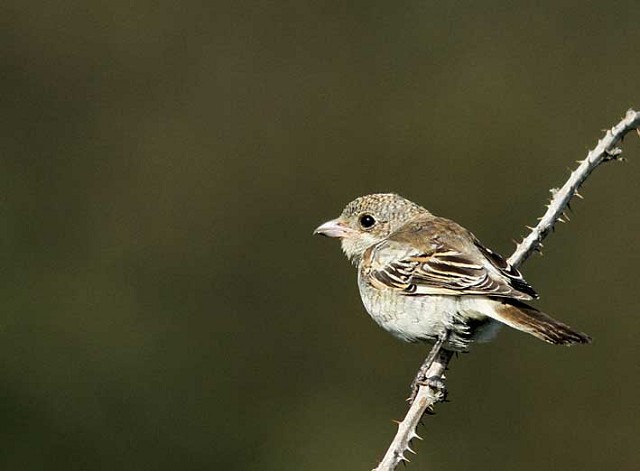
Woodchat Shrike, Lowestoft, Suffolk (Photo: Penny Clarke)
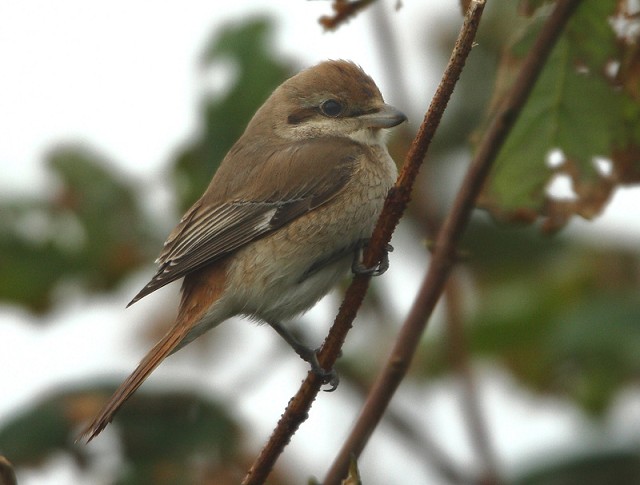
Isabelline Shrike, Levenwick, Mainland, Shetland (Photo: James Wood)

Isabelline Shrike, Hillwell, Mainland, Shetland (Photo: Mike Thrower)
The only Melodious Warbler reported was one that remained in Nanquidno Valley (Cornwall) to 9th, and the only Icterine Warbler was a possible at Peterstone Wentlooge (Gwent), also on 9th.
The first Pallas's Warbler of the year was an unconfirmed report from Durlston Country Park (Dorset) on 6th. The arrival of Yellow-browed Warblers along the east coast continued, with birds across many sites in the Northern Isles and between Lothian and Suffolk. They were noticeably absent from Lincolnshire and most of Yorkshire, though. In the west, birds remained at Soldier's Point (Anglesey) to 9th and on St Mary's (Scilly) to 12th, and new birds were at Brevig, Barra (Outer Hebrides) on 7th and on Bryher (Scilly) on 8th–11th. There were two at several sites, three remained at Mire Loch (Borders) to 9th and four were at Gunton (Suffolk) on 10th.

Yellow-browed Warbler, Burravoe, Yell, Shetland (Photo: Dougie Preston)
Numbers of Barred Warblers declined through the week, with most still concentrated in the Northern Isles. Further south, there were birds at three sites in Cork, one at Inishmore (Galway) on 12th and one seen again at Holme NOA (Norfolk) on the same day. On Scilly, the female Subalpine Warbler remained on St Mary's (Scilly) to 12th. Scilly also saw two of the week's Red-breasted Flycatchers, on St Agnes and St Martin's, whilst others were at Collafirth (Shetland) on 6th and on Barra (Outer Hebrides) on 8th–12th. Coincidentally, both of these last two sites also saw Little Buntings, on 6th and 10th–11th respectively. Others were at Geosetter and Scalloway (Shetland) on 6th. On Scilly, a Siberian Chiffchaff was on St Mary's on 12th and is presumably the same as the birds in the same area on 4th.

Red-breasted Flycatcher, St. Agnes, Isles of Scilly (Photo: Dave Perrett)
All the week's Lapland Buntings were coastal, though there are as many in the south now as the north. Peak counts were of just six on Holy Island (Northumberland), five at Lerwick (Shetland) and five at Kelling Water Meadow (Norfolk). Two new Red-eyed Vireos were reported this week, one with a tit flock at Stornoway, Lewis (Outer Hebrides) on 9th and the other on Cape Clear (Cork) on 10th, the third in the county this year.

Lapland Bunting, Fort Island, Isle of Man (Photo: Brian Liggins)

Red-eyed Vireo, Cape Clear, Cork (Photo: Ronan McLaughlin)
As with so many other migrants, Common Rosefinches were concentrated in the Shetlands, though not in any numbers. Further south, birds were at Kilnsea (East Yorks) on 8th–12th, on Lundy (Devon) on 11th, at Three Castles Head (Cork) again on 9th and on Bryher (Scilly) on 9th–10th. Late news also surfaced this week of a male Two-barred Crossbill photographed at Holystone (Northumberland) on 30th, with a second bird possibly also present. All the week's Rose-coloured Starlings were in the south, with the furthest north being at Holyhead (Anglesey) on 10th. Another Welsh bird remained on Skomer (Pembrokeshire) to 8th and the only Irish bird was on Cape Clear (Cork) on 10th–12th. Elsewhere, one remained on Lundy (Devon) to 8th, the Cornish bird moved to St Just on 6th–11th and new birds on Scilly were on St Mary's on 9th–12th and on St Martin's on 9th.

Common Rosefinch, Kilnsea, East Yorkshire (Photo: Andy Hood)

Rose-coloured Starling, St. Mary's, Isles of Scilly (Photo: Dave Perrett)
Last but not least, some interesting escapes this week included two South African Shelducks at Campfield Marsh (Cumbria) on 10th, a White-winged Dove in Ealing (London) on 9th and a Lilac-breasted Roller at Abbots Ripon (Cambs) on 7th.
Photo of the Week: 6th–12th October
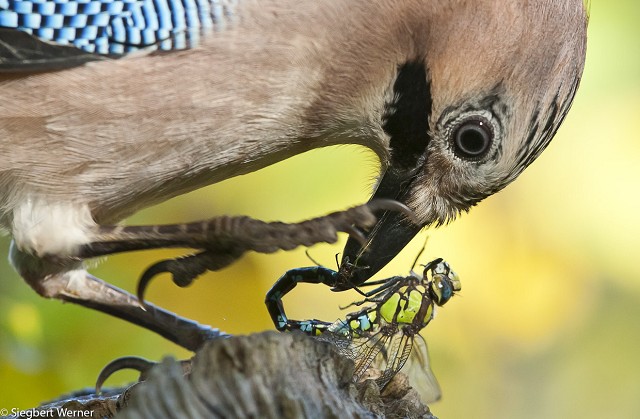
Jay, Germany (Photo: Siegbert Werner)
German bird photographer Siegbert Werner has a talent for creating images that are different enough to stand out from the crowd. His latest image of a Jay preparing to devour a dragonfly is no exception. Taking advantage of the sluggishness of dragonflies in the early morning chill, this Jay has found itself an easy meal. With perfect timing, Siegbert has frozen the action with the pin-sharp 'faces' of both creatures only millimetres apart and a compelling 'eye-line' connecting predator and prey. The current trend in bird photography is towards more 'environmental' images illustrating birds in their natural settings, but Siegbert shows that, for some situations, there's no substitute for a tight, close-up crop to give the image real impact.
Other notable photos

Red Grouse, undisclosed site, North Yorkshire (Photo: Richard Steel)
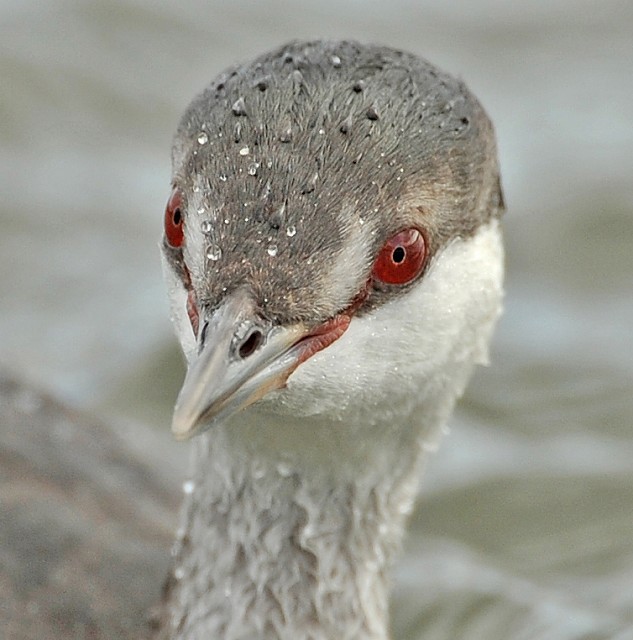
Slavonian Grebe, Fairhaven Lake, Lancashire (Photo: Brian Rafferty)

Hen Harrier, Kirk Michael, Isle of Man (Photo: Ted Jones)
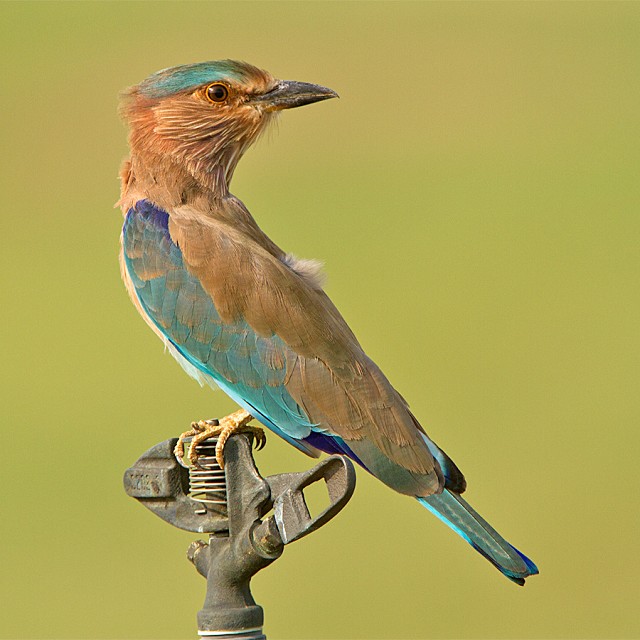
Indian Roller, Dubai (Photo: Jamie MacArthur)
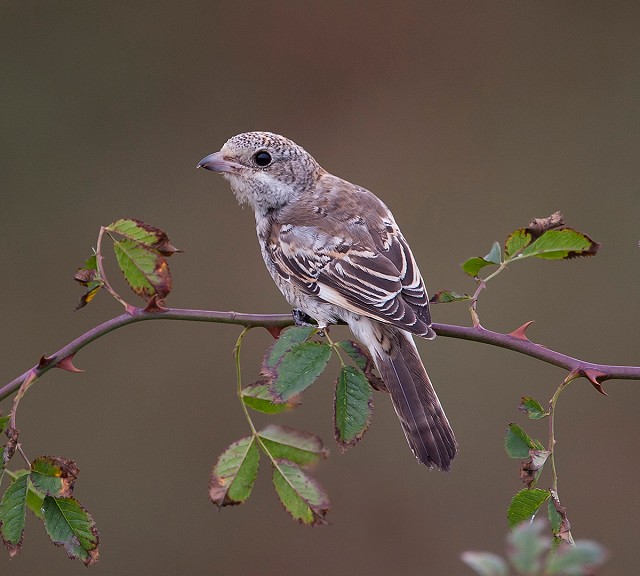
Woodchat Shrike, Lowestoft, Suffolk (Photo: Kevin Du Rose)

Whinchat, Greece (Photo: Ivan Ellison)

Greenshank, Hungary (Photo: Eduardo Balogh)
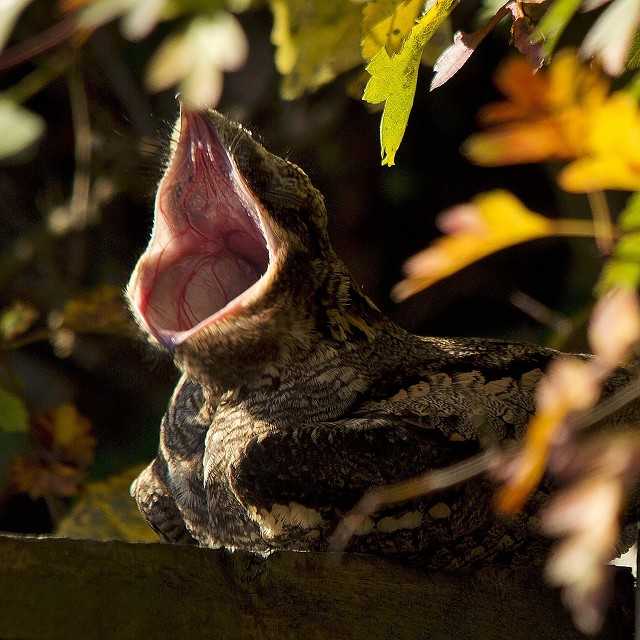
Nightjar, Codnor, Derbyshire (Photo: Mr Clive Daelman)

Little Owl, Portland, Dorset (Photo: Kev Joynes)

Common Kestrel, Westleton Heath, Suffolk (Photo: Jon Evans)
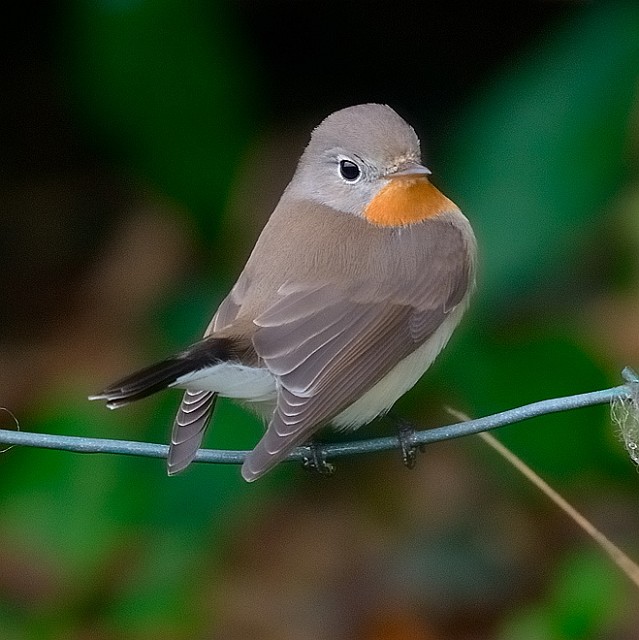
Red-breasted Flycatcher, Collafirth, Northmavine, Mainland, Shetland (Photo: Mike Thrower)
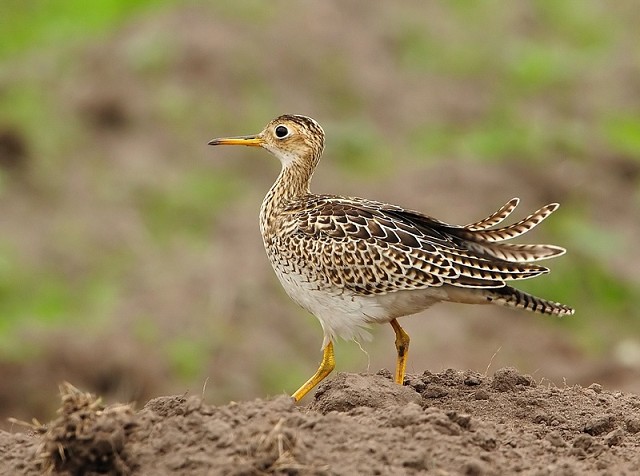
Upland Sandpiper, St. Mary's, Isles of Scilly (Photo: Dave Perrett)

Dotterel, Great Orme, Conwy (Photo: Steve Round)

Long-billed Dowitcher, Poland (Photo: MateuszMatysiak.PL)
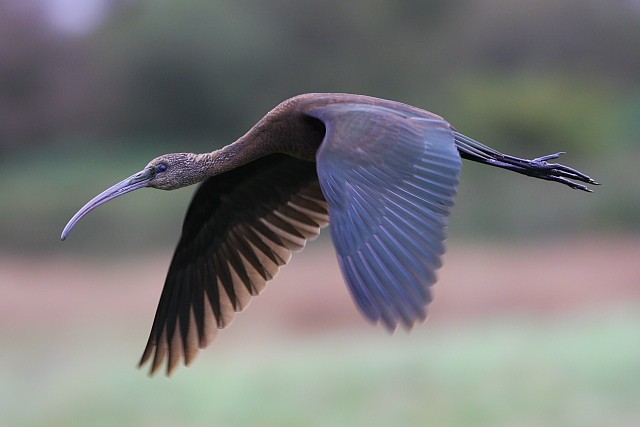
Glossy Ibis, Stanpit Marsh, Dorset (Photo: Peter Moore)
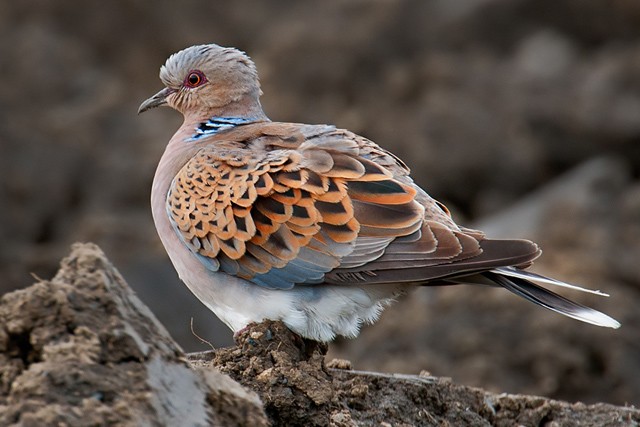
Turtle Dove, Big Waters NR, Northumberland (Photo: Derek Bilton)
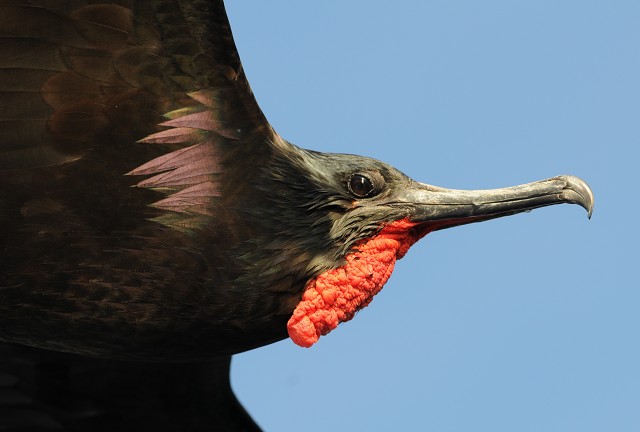
Magnificent Frigatebird, Ecuador (Photo: Sean Johnston)

Dunlin, Leasowe, Cheshire (Photo: Joe Wynn)

Hobby, Portbury Wharf, Somerset & Bristol (Photo: Pete Blanchard)

